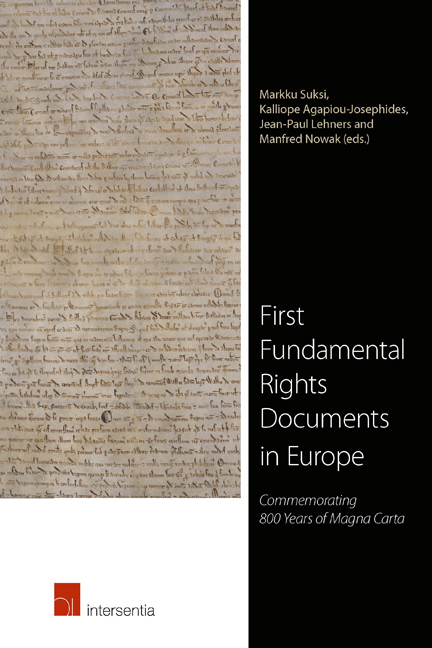Book contents
- Frontmatter
- Preface
- Contents
- List of Authors
- 1 Introduction
- PART I
- PART II
- 11 France: Foundational Importance of the Declaration of 1789
- 12 Sweden: Free Press as a First Fundamental Right
- 13 The Netherlands: The Batavian Staatsregeling as the First Fundamental Rights Document
- 14 Portugal: ‘Tropical Versailles’ in the Beginning of the Nineteenth Century
- 15 Luxembourg: Fundamental Rights in a Small State
- 16 Greece: Reflections from the Hellenic Legal Tradition
- 17 Denmark: In Love with Tradition
- 18 Germany: Fundamental Rights as an Instrument Towards the Rechtstaat
- 19 The Czech Republic: On the Road to Rights and Freedoms
- 20 Romania: The Birth of Fundamental Rights as a Form of Political Contention
- 21 Bulgaria: The Liberal Tarnovo Constitution
- 22 Finland: Rights to Facilitate Participation
- 23 Estonia: First Landmarks of Fundamental Rights
- 24 Slovakia: The Right of a Nation
- 25 Latvia: Second Part of the Constitution as a Project for Next Generations
- 26 The History of Fundamental Rights in Europe: A Long and Winding Road
- Index
23 - Estonia: First Landmarks of Fundamental Rights
from PART II
Published online by Cambridge University Press: 15 December 2017
- Frontmatter
- Preface
- Contents
- List of Authors
- 1 Introduction
- PART I
- PART II
- 11 France: Foundational Importance of the Declaration of 1789
- 12 Sweden: Free Press as a First Fundamental Right
- 13 The Netherlands: The Batavian Staatsregeling as the First Fundamental Rights Document
- 14 Portugal: ‘Tropical Versailles’ in the Beginning of the Nineteenth Century
- 15 Luxembourg: Fundamental Rights in a Small State
- 16 Greece: Reflections from the Hellenic Legal Tradition
- 17 Denmark: In Love with Tradition
- 18 Germany: Fundamental Rights as an Instrument Towards the Rechtstaat
- 19 The Czech Republic: On the Road to Rights and Freedoms
- 20 Romania: The Birth of Fundamental Rights as a Form of Political Contention
- 21 Bulgaria: The Liberal Tarnovo Constitution
- 22 Finland: Rights to Facilitate Participation
- 23 Estonia: First Landmarks of Fundamental Rights
- 24 Slovakia: The Right of a Nation
- 25 Latvia: Second Part of the Constitution as a Project for Next Generations
- 26 The History of Fundamental Rights in Europe: A Long and Winding Road
- Index
Summary
‘Chapter II of the Constitution of the Republic of Estonia deals with fundamental rights of the citizens. This, as Prof. Dr. Berendts writes — “is precious treasure, which is granted and given to Estonian citizens, treasure, without which a human becomes physically, mentally and spiritually a slave.” It is necessary to take care that this treasure does not remain only on paper as a dead letter, but must find just application in real life.’
Meinhard Vasar, attorney at law, in 1932INTRODUCTION
The question of exactly when the first signs of fundamental rights in the territory of the current Republic of Estonia were clearly established is not easy to answer. Would it be correct to begin with the Fundamental Laws of the Russian Empire from 23 April 1906, or should we begin the story about fundamental rights in Estonia with the first Constitution of the Republic of Estonia which was passed by the Constituent Assembly (Asutav Kogu) on 15 June 1920 and entered into force on 21 December 1920? Estonian legal historian T. Anepaio takes one step further and suggests that the first acts establishing certain fundamental rights were introduced with the judicial reforms of 1889 by the Emperor of Russia, Alexander II. Thus, the question is: should we draw a line between the legal acts of the Russian Empire and Estonia's own national pre-constitutional and constitutional legal acts?
New problems and possibilities for subjective interpretation arise, however, even if we frame the discussion only in terms of national Estonian legal acts. In the theory of constitutional law there have been discussions concerning which documents are, per se, pre-constitutional. In the interwar period, the Estonian leading legal theorist and specialist in administrative law, A. T. Kliimann (1899–1941), based his theory on the basic formative steps of national independence. According to Kliimann, the important pre-constitutional acts of Estonia were as follows: firstly, the decision of the Estonian National Council (Maanõukogu otsus); secondly, the Manifesto to All the Peoples of Estonia, known as the Declaration of Independence, of 24 February 1918 under which Estonia was a democratic republic from 15 November 1917, followed thirdly by the Temporary Regime of Government of the Republic of Estonia passed by the Constituent Assembly on 4 July 1919.
- Type
- Chapter
- Information
- First Fundamental Rights Documents in EuropeCommemorating 800 Years of Magna Carta, pp. 295 - 308Publisher: IntersentiaPrint publication year: 2015



